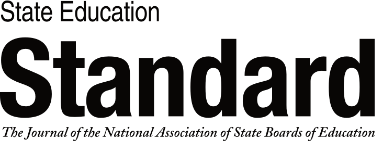Preparing Students for Informed, Active Citizenship: Lessons from Illinois
Illinois Democracy Schools are a key element of the state’s comprehensive approach.

Over the past decade, Illinois has emerged as a national exemplar of how state policy can drive systemic change in civics education. With bipartisan support and propelled by landmark legislation, the state in 2015 enacted requirements for civics coursework in high school and in 2020 for middle school.[1] These reforms were not top-down mandates alone—they were the result of strategic cross-sector collaboration and grassroots support.
At the center of this work is the Illinois Civic Mission Coalition, a pan-ideological alliance of educators, policymakers, and civic organizations that shaped the state’s civics education vision. The coalition advocated for policy change while simultaneously preparing the conditions for effective implementation through a comprehensive statewide model.
To ensure fidelity and equity in its execution, Illinois civic leaders employed community needs assessments and continuous evaluation cycles. They built a scalable infrastructure of support through the Illinois Civics Hub, which serves as the operational backbone for implementation. Key supports include the following:
- multiday professional learning institutes for educators and administrators;
- online microcredentials aligned to instructional best practices and state standards; and
- a regional mentorship program to facilitate peer-led guidance and support.[2]
Together, these components reflect a whole-district, cross-curricular approach to civics learning that centers educator capacity, local context, and data-informed decision making.
Both legislative mandates were designed to ensure that secondary-level students receive robust instruction in government, current issues, and participatory civic problem solving, while gaining valuable hands-on experience in democratic citizenship. The impact was dramatic: Just two years after the high school civics mandate came into effect, interest in implementing the new civics course among principals grew from 68 percent in 2017 to 81 percent in 2018. Similarly, superintendents’ interest grew from 53 percent in 2017 to 65 percent in 2018. Social studies teachers maintained a high level of interest, at 90 percent since the beginning.[3] Ten years after the high school civics course mandate came into effect, Illinois has achieved broad, consistent adoption of high-quality civics learning that can serve as a blueprint for other states.[4]
Just two years after the high school civics mandate came into effect, interest in implementing the new civics course among principals grew from 68 percent in 2017 to 81 percent in 2018.
In more than a decade of research-practice partnership between Tufts University and Illinois Civics Hub, our initiative yielded lessons that we hope are useful to leaders in other states. It was critical that there was a strong public-private partnership encompassing the Illinois State Board of Education, nonprofits, and district leaders. They coordinated their services around these new mandates under the Illinois Civics Hub, a website that has become a go-to resource for schools to understand the mandates and access resources and training. The state board has taken a proactive stance in bolstering civics education statewide. Under its auspices, the Illinois Task Force on Civic Education was convened in 2013 to conduct a comprehensive review of both Illinois’s civics instruction and models from other states, culminating in a 2014 report that recommended requiring a high school civics course, mandating service-learning projects in grades 6–12, revamping teacher licensure and professional development, and empowering student involvement in elections.
Through multiple iterations of statewide implementation, we identified four key ingredients to Illinois’s success in delivering high-quality civic learning:
- centering educator capacity and talent;
- remaining flexible and responsive to community differences;
- collaborating and building relational networks; and
- data-informed and local decision making.
Because Illinois leaders embraced educators as partners and respected the diversity of Illinois towns and cities, they built the capacity of local stakeholders to adapt implementation to fit each community. No budget line has been dedicated to strengthening civics learning in Illinois. These largely philanthropy-supported efforts are run by a small team at the Illinois Civics Hub, whose primary role is to advance the goals set by the Illinois Civic Mission Coalition’s consensus report. Without grassroots support, these mandates would not have flourished.
Illinois Democracy Schools
Another Illinois Civics Hub initiative that is complementary to the civics mandate are Illinois Democracy Schools (IDS). Schools in every corner of the state have opted to join this flourishing network of schools, which have committed to creating connected, meaningful civics learning opportunities across disciplines and grades. A recommendation of the Illinois Civic Blueprint, IDS supports over 90 schools, which enroll approximately one-sixth of all public Illinois high school students in Illinois.[5] These schools exemplify a cross-disciplinary, multistakeholder process for imagining and realizing comprehensive civic preparation for all students across the discipline.
[Illinois Democracy Schools] exemplify a cross-disciplinary, multistakeholder process for imagining and realizing comprehensive civic preparation for all students across the discipline.
Using a research- and community-informed framework,[6] the network supports a school-specific, whole-school civics learning agenda and provides resources and professional development that are responsive to expressed needs. To be recognized as an IDS school, a school must form a working group with representatives from school leadership, faculty, nonteaching staff, and students. The working group assesses how the school offers civics learning across the disciplines to meet four core priorities:
- excellence for all—ensuring equitable, relevant, rigorous civics learning for every student;
- inquiry as the primary mode of learning—promoting evidence-based, student-centered inquiry and discussion;
- practice of constitutional democracy and student agency—providing authentic opportunities for students to engage in experiential civics learning activities and collaborative decision making; and
- continuous assessment, reflection, and improvement—using self-reflection and data to enhance civics learning experiences.
Schools activate these principles by integrating evidence-based practice of civics learning and practices across the disciplines in ways that best suit their schools. As a result, IDS demonstrates the multiple benefits of this approach: student engagement, real-world impact, and hands-on learning of career-ready skills. More than 200 educators and staff attended a recent convening to share best practices and connect with other civics champions in Illinois.
Schools activate these principles by integrating evidence-based practice of civics learning and practices across the disciplines in ways that best suit their schools.
Other state coalitions have contacted leaders in Illinois to inquire how they might adopt this model in their communities. One of us (Mary Ellen) has worked with district leaders in Hawai‛i to adapt the Illinois Democracy Schools model, resulting in the Hawai‛i Schools of Democracy. Similar efforts are underway with partners in Wisconsin and Indiana, who are collaborating with IDS educators to advance civics education aligned with each state’s policies.
Stories from five Democracy Schools illustrate the varied ways these concepts are practiced and reflect the diversity of the network.
Navigating the Digital Age. Neuqua Valley High School, a suburban school in Naperville, Illinois, exemplifies how civic competencies can be integrated into existing coursework. Neuqua Valley partnered with Stanford University’s Digital Inquiry Group, whose Civic Online Reasoning curriculum is designed to help students evaluate the reliability of digital content.
“Our students are digital natives, but that doesn’t mean they’re digitally wise,” group director Joel Breakstone told teachers in a professional learning session. He emphasized that young people often lack the strategies necessary to verify information, making them vulnerable to online manipulation.
An interdisciplinary team of social studies, science, and library media educators co-created lesson plans that embedded digital literacy into core classes. World geography teacher Deanna Lindsey had students assess websites, infographics, and videos on topics like India’s population and water access. Biology teacher Adrianna Toomey used TikTok videos about health claims to introduce students to lateral reading, a technique where students investigate the source of a claim by opening new browser tabs to consult independent sources.
“This work helped students question sources they usually trust,” Toomey said. “They learned that not everything shared on a visually appealing or viral platform is reliable.”
Educators also noted the importance of sustained reinforcement. “We quickly saw that these skills fade if not practiced,” said Tom McManamen, social studies department chair. “Students need to revisit them in multiple contexts. Embedding across disciplines—and across grade levels—is essential.”
“Civic reasoning is like muscle memory,” added social studies teacher Kelli Tufo. “The more students practice it, the more second nature it becomes.”
The school leveraged the skills of library media director Carrie Ory to lead resource curation and cross-departmental dialogue. “The collaborative space we created for teachers was just as important as the student outcomes,” Ory said. “We aligned on purpose and pedagogy.”
Participatory Budgeting. Spoon River Valley Jr/Sr High School, a small rural school in central Illinois, made its civic mission tangible through participatory budgeting—a cornerstone of its emphasis on student voice and agency. In this grant-funded initiative, students were given a real budget and authority to decide how to spend it for the betterment of their school.
Led by teacher Jennifer Burdette, seniors in a current events course formed the high school steering committee, while the junior high student council did the same for their peers. Each committee controlled a $2,000 budget and identified priorities, researched feasibility, consulted stakeholders, and ultimately held a schoolwide vote.
“This project was more than a simulation,” Burdette said. “It was real money, real decisions, and real civic deliberation. Students had to confront trade-offs, advocate for their ideas, and work collaboratively.”
Students began by conducting structured school walkthroughs, noting areas for improvement and engaging classmates and teachers. The high school group hosted a lunch-table feedback station—complete with candy incentives—to encourage input via Google Forms. “We didn’t want it to just be our voices,” a student on the committee said. “We wanted to hear from everyone.”
Students began by conducting structured school walkthroughs, noting areas for improvement and engaging classmates and teachers.
They narrowed their list through committee deliberation and cost-benefit analyses. Students then divided into proposal teams to assess feasibility by itemizing costs, identifying what approvals were needed, and anticipating challenges. They presented final proposals to school administrators.
“A lot of us thought the administration wouldn’t listen,” admitted one senior. “But after our meeting, I realized they have rules to follow, too. It’s not that they don’t care; it’s that sometimes there are limits.”
The most popular high school proposal was the creation of a student-run coffee shop. In partnership with business teacher Michelle Olson, students developed menus, pricing, branding, and operational plans. “They weren’t just learning entrepreneurship,” Olson said. “They were living civic agency. They saw firsthand how schools operate and what it takes to change something.”
The high school students then mentored the junior high participants through their own budgeting cycle, a replication that Burdette called transformational for both age groups. Despite time constraints, middle school students launched their own proposal process with support from older peers.
“Before this, I thought making change was just about money,” said one eighth grader. “But I’ve learned that effort, teamwork, and listening matter more.”
Student-Led Candidate Forum. West Chicago Community High School, a diverse suburban district with one-third of students identified as English learners, focused its civic learning on informed, equitable voting. After social studies teacher and Illinois Civics Hub instructional coach Candace Fikis attended a four-day institute, she catalyzed a classroom project that culminated in a student-organized candidate forum, held in partnership with the League of Women Voters of Wheaton.
“I wanted students to move beyond apathy or surface-level knowledge of elections,” Fikis said. “The institute gave me the tools, and my students ran with them.”
Students identified community concerns by interviewing at least three adults about the issues they cared most about. These conversations informed the development of forum questions. “I never thought about property taxes or water bills before,” one student confessed. “But now I understand how these decisions affect people.”
Students identified community concerns by interviewing at least three adults about the issues they cared most about. These conversations informed the development of forum questions.
Students researched state legislative candidates, created handouts, and facilitated the forum itself, posing questions directly to candidates. Though only a handful of students were eligible to vote, many reported sharing resources and websites with their families to help eligible members of the electorate cast informed ballots. A few even applied to serve as election judges, prompting what Fikis called “a record number of student applications in our district.”[7]
The project continues to resonate. “The League of Women Voters asked for our students’ questions to use in future events,” Fikis said. “That kind of validation shows students their voice matters—not just in school, but in the wider community.”
Service Learning. At Mendota High School, a rural school in north-central Illinois, educators Jason Artman and Aaron Sester guided students through an interdisciplinary inquiry: “How responsible are we for preserving the environment for the future?”
This question launched a semester-long investigation into the civic dimensions of environmental stewardship. Students explored arguments about whether environmental preservation is primarily the role of government or individuals. They researched keystone species, particularly bees and pollinators native to the Midwest, and identified an overgrown prairie plot on school grounds as an ideal site for civic action.
The project included planning with other classes, survey research with faculty, stakeholder outreach, and funding through an environmental grant. The students’ inquiry revealed that a retired science teacher and an Eagle Scout had created the plot many years prior to its current disuse. The land sloped toward a nearby lake, and much of the trash littering drainage ditches came from a nearby highway. “This helped students understand how land use and community behavior intersect—and how civic action can begin right outside the school building,” Artman said.
Next steps include planting a new pollinator habitat and involving incoming students in its maintenance. The project not only built students’ civic mindset and skills, but also skills such as planning a complex workflow and collaboration. “They’ve learned to ask questions, reflect, and take action,” Artman said. “Whether or not the habitat thrives, the civic habits will.”
Integrating Civic Reasoning in Mathematics. Five math teachers from across the state joined in a community of practice to develop pilot lessons that ask students to apply math and data analysis to real-world civics debates over, for example, health insurance and the minimum wage.
“Although the lessons didn’t always push complex mathematical thinking, they made simple math feel consequential,” one teacher said. “That’s powerful for students who may not always see the relevance of what we do.”
Another said, “My students could finally see how linear functions aren’t just graphs—they’re tools for analyzing economic inequality or healthcare costs.”
The civics connections were explicit and robust. Students analyzed how government policies like fines and minimum wage laws are created, who they benefit, and who they burden. “We asked students to choose the issues they wanted to explore using math,” one teacher said. “That was the key. The conversations we had were the best of the year. They were theirs.”
Framework. Each case demonstrates how the IDS framework functions as more than a checklist or compliance document. Instead, it provides a scaffold to cultivate civics learning that is
- instructionally integrated across disciplines, not siloed in civics classrooms;
- youth-centered, granting students an authentic voice in decision making; and
- schoolwide, with leadership and faculty alignment that fosters systemic change.
The framework encourages schools to align their civics learning with existing culture and programs while making sure that schools’ decisions are made based on data they gather. These efforts create an expectation for many more educators than social studies teachers alone to prepare students for democratic citizenship.
Roadmap to Successful Implementation
As a community-led, voluntary network, the IDS framework has evolved based on continual discussions with educators, administrators, and community stakeholders who use it. Originally, network schools took a social studies–centric approach in which schools were recognized for their commitment to preparing students for civic life through coursework in history and civics. Over the years, IDS began to encourage all educators to advance civics learning for all students in their schools. In other words, everyone contributes to student civics learning. To embrace all types of communities and perspectives into the network, the framework provides examples of how schools have decided to execute each core principle and offers a glossary to make sure diverse stakeholders can fully participate in the process.
As a community-led, voluntary network, the IDS framework has evolved based on continual discussions with educators, administrators, and community stakeholders who use it.
As other states and school systems look to expand civics learning, the Illinois model offers a roadmap for transforming state policy into practice—and for transforming students into lifelong civic participants. What started out as a small pilot in 2006 has now been used and adopted by over 90 schools supporting over 120,000 students, in rural, urban, and suburban schools.
While civics education mandates in Illinois have sometimes been labeled as “woke,”[8] Illinois Democracy Schools have nonetheless flourished. Having led, assessed, and collaborated closely with the network, we believe IDS has been embraced by a wide and diverse array of schools because it provides opportunities to reimagine and strengthen student preparation for civic life—without requiring schools to do anything they are uncomfortable with. Additionally, the program operates within clear guardrails grounded in evidence-based practices. Examples showcased on the IDS website highlight the many ways schools activate each IDS principle, demonstrating the network’s commitment to embracing diverse viewpoints and ideas.
Illinois Democracy Schools continue to evolve. Over the past two years, a vertically aligned K-12 model has been developed with feedback from educators, students, support staff, parents, and community members. This fall, IDS will welcome its first elementary and middle schools into the network at its annual convening, with pilot schools suggesting modifications for each grade level.
The holistic approach to civics learning that the IDS model represents gives each state, district, and school a way to design and offer cross-disciplinary civics learning opportunities to students in partnership with communities. Education stakeholders and families recognize the importance of preparing the next generation for informed, consistent participation in civic life. And so do students. As one student at Spoon River Valley said, “Before this project, I thought democracy was just voting. Now I know it’s about listening, compromising, and making something better together.”
Kei Kawashima-Ginsberg, Ph.D., is a leading expert in youth civic engagement and education affiliated with America’s Promise Alliance and Purpose of Education Fund, and she is a past director at the Center for Information and Research on Civic Learning & Engagement (CIRCLE) at Tufts University. Mary Ellen Daneels, MS.Ed., is a National Board Certified Teacher and directs the Illinois Civics Hub and the Illinois Democracy Schools Network.
Notes
[1] Illinois General Assembly, Public Act 099-0434 (2015) and Public Act 101-0254 (2019).
[2] Noorya Hayat and Kei Kawashima-Ginsberg, “Building for Better Democracy: Final Report on the Illinois #CivicsIsBack Civic Education Initiative” (Center for Information and Research on Civic Learning and Engagement, Jonathan M. Tisch College of Civic Life, Tufts University, May 11, 2020).
[3] Hayat and Kawashima-Ginsberg, “Building for Better Democracy.”
[4] Several evaluation reports document the effectiveness of various components of this model. Kelly Siegel-Stechler et al., “An Evaluation of Illinois Middle School Civics Implementation Progress” (Center for Information and Research on Civic Learning and Engagement, Jonathan M. Tisch College of Civic Life, Tufts University, September 2023); Hayat and Kawashima-Ginsberg, “Building for Better Democracy”; Jacob Berkman, “What States Can Learn from How Illinois Implemented Its 2015 Civic Education Law,” report (iCivics, February 2020).
[5] McCormick Foundation, “Illinois Civic Blueprint,” 2nd ed., report (Chicago: McCormick Foundation, 2013).
[6] Educating for American Democracy, “Pedagogy Companion to the Roadmap to Educating for American Democracy”; Cathy Cohen, Joseph Kahne, and Jessica Marshall, “Let’s Go There: Making a Case for Race, Ethnicity, and a Lived Civics Approach to Civic Education,” report (GenForward at the University of Chicago, 2018).
[7] In most states, 16- and 17-year-olds can apply to serve as poll workers. In some municipalities, poll workers are called election judges, but underage election judges do not perform duties such as ballot counting.
[8] Stanley Kurtz, “Ultra-Woke Illinois Mandates Are Top Threat to US Education,” National Review, January 19, 2021.
Also In this Issue
The Challenges of Crafting Excellence in Civics and History for All
By Danielle Allen, Paul Carrese and Louise DubéThree authors of Educating for American Democracy revisit five aims depicted in their roadmap—and the miles to go.
The State of Youth Civic Engagement
By Jessica Sutter and Audra WatsonUnderstanding young people’s attitudes toward democratic participation can help states summon the resolve and the wisdom to strengthen civics learning.
Six Things State Leaders Can Do to Invigorate US Civics and History Learning
By Chester E. Finn Jr.Broad public agreement on what students ought to learn should propel their efforts, as should the lack of confidence in democratic institutions.
The Science of Experiential Civics
By Pamela Cantor MD, Fernande Raine and Susan RiversYoung people are wired for civics learning that connects them to their communities, builds their agency, and leverages relationships.
Recognizing Students and Schools for Civics Learning
By Andrea Benites, Lisa Boudreau and Shawn HealyTo boost critical knowledge and skill building, some states offer diploma seals and school recognition programs.
Preparing Students for Informed, Active Citizenship: Lessons from Illinois
By Kei Kawashima-Ginsberg and Mary Ellen DaneelsIllinois Democracy Schools are a key element of the state’s comprehensive approach.








 i
i
 i
i